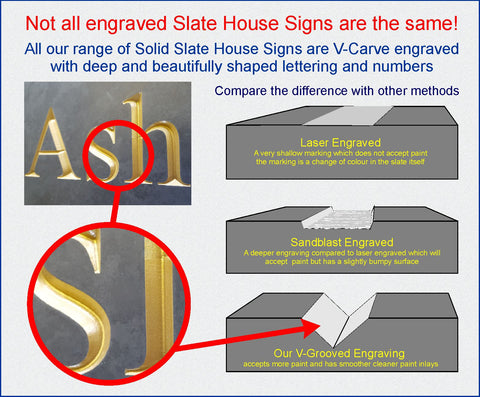
Comparing the difference of our V-grooved engraved signs with sandblasted signs or laser engraved
Many website visitors call us to ask what exactly is the difference between our V-Grooved (also known as V-Carved or V-cut) slate house signs and white V-carved range of signs and the sandblasted or laser engraved slate signs offered by many of our competitors
Laser engraving is done by a high power laser focusing on the face a the slate sign. This burns the slate and changes the colour of the slate to off white which contrasts against the darker slate but it is just a shallow marking and can’t be successfully colour inlaid. When the engraving gets wet in the rain outdoors the laser engraving can just disappear!
Sandblasted signs are made by sticking down a rubber stencil onto the face of the plaque and spraying grit at high pressure through the stencil. This erodes away the slate inside the stencilled parts– A pretty quick way of creating a reasonable engraved text in the stone and it can be colour inlaid. Sandblasted slate has a shallow flattened engraving and the flattened area also has a slightly ‘bumpy’ surface
Our engraving method is by using a CNC router which is spinning a ‘V’ shaped router bit at high speed to engrave deeply into the sign. This method takes longer but the result is much crisper lettering with a much deeper cut and smoother lines in the text. We think this is the ultimate in stone engraving methods.
Slate house sign in gold from housesignshop
Did you Know? V-carving text into stone has been around for thousands of years. It was used by the Romans and Greeks and other ancient civilizations with great success and the inscriptions can still be seen and read today – they used a V shaped chisel and mallet to engrave their lettering text by hand. Through the years V grooved text became popular in the UK for memorials, commemorative plaques and house name and number plaques.

